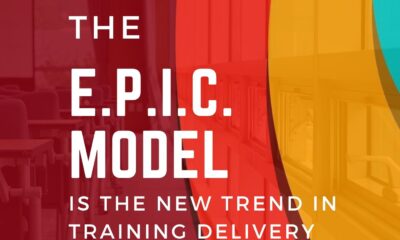Basics
How to Start with Human Resources Management?

The human element is the most important resource for any organization at all administrative levels. The human element is the one who sets goals, plans, and provides the financial and material resources necessary to carry out the various tasks, as well as the one who determines the organization’s values and culture, analyzes problems, and makes decisions regarding them.
What is human resources management?
Human resources management (HRM) is the practice of recruiting, hiring, deploying, and managing an organization’s employees. HRM is often referred to as human resources (HR). An organization or organization’s HR department is normally accountable for creating, placing into impact, and overseeing policies governing people and the relationship of the organization with its employees.
When did human resources management start?
Human sources management was first used in the early 1900s, and became more extensive in the 1960s, to manage the people who work for the organization.
The importance of human resources management:
The importance of human resources management lies in the importance of the human resource itself. The quality of management is related to the effectiveness and efficiency of people’s operations, starting from the selection and qualification process to the processes of calculating wages, reward, promotion, and accountability, as all factors interact together and directly affect the human being, his emotions, his orientations, and his productivity at work.
Objectives of human resource management:

The role of HRM can be categorized into four main objectives:
- Societal objectives: Taking the necessary measures towards meeting the social needs of both the organization and its employees in light of legal framework and social and cultural determinants, as well as facing the challenges associated with them, such as the minimum wage.
- Organizational objectives: The Human Resources Department works within the determined framework by the organization’s leaders, which helps to achieve organizational goals such as work teams or hierarchical organization, including the powers, channels of communication, and chain of command, which places the responsibility of the Human Resources Department to address the description of each job, tasks, and responsibilities, as well as channels of communication, as well as selection criteria of employees.
- Functional objectives: The functional objectives of the Human Resources Department are represented in the operational processes that it undertakes, which are:
- Selection and recruitment
- Induction and qualification
- Career path planning
- Follow-up and evaluation
- Promotion and reward
- Wage determination
- Accountability and investigation
These functions cover the basic operations of human resource management and draw up guidelines to maintain the effectiveness and efficiency of employees to achieve the objectives of the organization.
- Personal objectives: The human resources department also adopts personal goals for employees and creates the environment that helps to achieve them. There are many and varied personal goals for employees related to the job, social and financial status, as well as the culture and values of society, which leads to employees’ stability at work. This makes the continuous monitoring of the human and professional needs of employees on the list of priorities for successful human resources management because of its impact on the stability of both the organization and individuals and their sense of justice.
Functions of human resources management:

- Planning
- Staffing
- Developing
- Motivating
- Managing change
- Maintaining relationships
- Evaluating
- Appraising
1- Planning:
- Analyze objectives:
Planning is a continuous process carried out by the organization to achieve goals, as the processes of setting goals and planning are inseparable, as goals cannot be achieved without a plan and planning cannot be done without a goal.
The objectives of human resource management fall within the main goals of the organization, as they must be consistent with them to become applicable. Therefore, the human resources department must study and analyze the organization’s goals to determine its role in achieving those goals, whether by attracting new workers, laying off some workers, modifying some jobs, or training workers in skills required to implement the organization’s plan.
- Analyzing current human resources:
One of the most important steps of the planning process is to assess the current situation of human resources to determine the capabilities and factors of strength, weakness, and deficiencies in the concerned organization at present or in the future, where knowledge of these data helps in the process of proper planning and efficient and effective implementation.
- Forecast demand:
Demand forecasting helps to know the organization’s future needs of human resources in terms of number, qualifications, and specialization to achieve the necessary competence and efficiency to achieve the tasks. There are a set of statistical methods that organizations use to forecast demand, such as:
-Projection
-Average
-Regression analysis
- Estimate gaps:
The gaps are identified by comparing the results with the goals, which is one of the recent trends called (OKRs) or Objectives and Key Results through which the results are compared with the goals and then identifying the gap between reality and desired results and developing solutions to solve that problem.
- Formulate plan:
This step comes after completing the previous steps and collecting sufficient information to make the right decision when making a comparison between the proposed alternatives. Where the plan must be a reflection of the organization’s goals, as well as be efficient in terms of using the available resources and managing them effectively.

- Implement plan:
Plan implementation comes after completing the previous steps and collecting sufficient information to make the right decision when making a comparison between alternatives. Where the plan must be a reflection of the organization’s goals, as well as be efficient in terms of using the available resources and managing them effectively. Therefore, goals must be turned into numbers and a time frame has to be set for effective monitoring of the plan’s implementation.
- Monitor, control and feedback:
It is the process of monitoring and identifying deviations in addition to identifying the problems by periodically comparing the actual performance with the standards and developing fundamental solutions to them.
The monitoring and control process can be clarified through the following steps:

2- Staffing:
It is intended to supply the organization with employees through the following:
- Determining the required jobs
- Setting standards for each job
- Determining the necessary skills and previous job experiences to perform the job
- Determining the academic and educational requirements
- Determining the selection criteria among applicants
- Placing the job in the appropriate salary structure.
- Drafting the job offer and negotiating with the selected applicant.
3- Developing:
The tasks of human resources management extend to developing the skills of employees, whether technical or administrative, to keep pace with the state of development that occurs in the business environment. The Human Resources Department is also concerned with developing the basic skills of employees, which include:
- communications skills
- Teamwork / team building
- Crisis management
- problem solving and decision making
- Information security
- Dealing with work stress and job burnout
- Embracing diversity
along with formulating development strategies to build the capacity of the human capital and prepare leadership cadres such as:
- Job enrichment
- Empowerment
- Organizational commitment
- Organizational learning
- Self-managed work teams
- Career path planning
- Talent acquisition
- Innovation management
- intellectual capital management
- Transformational leadership
4- Motivating:
Motivation plays a great role in supporting the organization’s employees and urging them to make efforts to achieve the desired goals. Therefore, the Human Resources Department plays an important role in motivating the employees and taking the necessary measures for this through continuous evaluation of employees’ performance and recognition of extraordinary efforts to determine the persons worthy of reward and recognition.
5- Managing change:
Change in the simplest form is to move from the current situation in which we live to a future situation that will be more efficient and effective. There is no doubt that the world today is in constant conflict with the desire to bring about change, as a result of the tremendous progress in science and technology and the resulting economic, social and cultural change, until we now live in the information era after we lived in the industrial and agricultural eras. Change has become a reality in the life of societies and organizations, and managing the change process has become one of the most important tasks undertaken by the manager in modern organizations, meaning that shaping the future has become mainly dependent on making the change on an ongoing basis.
The importance of change management:
- Maintaining the effectiveness of the organization
- Developing the desire and ability to innovate
- The need to make compatibility with the environmental variables surrounding the organization
- Reaching a higher degree of strength and performance in the organization
The main factors that lead to change (the force of change):
The forces of change may come from within the organization (internal pressures) and may come from outside the organization (external pressures).
Internal pressures:
- Dissatisfaction with the performance of the various activities or the level of service provided.
- The desire to improve the organizational efficiency of the organization.
- The need to fulfill the increasing human needs of individuals within the organization.
- There is underemployment in the organization and the need to re-plan the workforce and training.
External pressures:
- Economic conditions.
- Social conditions.
- Technological development.
- Political circumstances.
- The legal frame.
- Cultural variables.
In addition to other contemporary international concerns such as the pandemic, which in turn may lead to the need to change the policies of the organization.
The process of change management:

The Unfreeze Phase:
This is when the organization feels that there is a need for change. This stage is the preparation for the change process, thus senior management seeks at this stage to provoke individuals to feel and realize the need for change, and here establish strong relationships with them, as the planned change will not have a chance of success in the long run unless there is a review of trends and behaviors (the old behavior) and at the same time there is a willingness to work differently from this old behavior. There may be differences in visions and ideas, which requires a method that helps employees to get rid of old habits to other alternatives that are more positive in performing the functions entrusted to them.
The Changing Phase:
At this stage, the change process is initiated, where the senior management initiates the change process through the components of the organization (the human element – tasks and competencies – organizational structures – modern technology) and that is after an in-depth diagnosis of each of these problems and identification of possible alternatives that can be chosen to bring about the change process.
Some organizations try to speed up the change process, however, they end up failing because the employees did not feel the need for change, and therefore they create an opposite reaction that results in resistance to change, due to their ignorance of the elements of the change process or the speed in achieving change.
Refreeze Phase:
This step represents the final stage of the change process when the organization seeks to stabilize and maintain the change that has been reached in (behavior or trends) while creating the appropriate conditions for the continuity of change for the longest possible period, and the change that has been achieved can be maintained through performance reward, support for the desired behavior and positive feedback.
6- Maintaining relationships:
Employee relationships can develop between coworkers as well as the employee and the organization. This relationship can boost their productivity due to a positive relationship as there is a correlation between productivity and the work environment.
How does HRM manage employee relationships?
Human resources management is entrusted with all necessary means to motivate, capacitate and enhance people’s productivity therefore there are a set of actions that can be taken to maintain employee relationships namely:
- Coworkers relationship:
- Building work teams
- Encourage social interactions
- Support team building activities
- Enabling means of communication
- Take advantage of informal organization
- Employee – organization relationship:
- Holding meetings either one on one or group
- Monitoring employees’ satisfaction
- Adopting the policy of engagement and accountability for actions
7- Evaluating:
The Human Resources Department is entrusted with evaluating the plan that has been developed, whether to recruit a competent workforce or to make optimal use of the available human resources or to develop and raise their efficiency, through key performance indicators (KPIs) that are determined in advance for the periodic measurement of the department’s ability to implement the plan and commitment to the schedule. The evaluation is based on data collected by one or a combination of the following methods:
- Observation
- Checklists
- Surveys
- Focus groups
- Usage data
- Interviews
- Documents and records
HR KPIs reflect organizational performance for HR, as they are described primarily based on the HR results that are applicable to acquire the organization’s goals.
- Absenteeism Rate: Evaluate the engagement of your employees
- Overtime Hours: Monitor your employees’ workload in detail
- Training Costs: Analyze the investments in your employees
- Employee Productivity: Track the overall effectiveness of your workforce
- Talent Satisfaction: Ensure your employees are satisfied in the long run
- Cost per Hire: Analyze what it takes to find the perfect fit
- Recruiting Conversion Rate: Find the best recruitment method
- Time to Fill: Monitor how long you need to find a new employee
- Talent Rating: Assess the quality of your employees
- Employee Turnover Rate: See how your retention efforts work
- Talent Turnover Rate: Evaluate how many talents you continually change
- Dismissal Rate: Find out if you’re recruiting the right employees
- Female to Male Ratio: Understand the gender diversity in your company
- Part-Time Employees: Watch the evolution of part-time workers over time
- Average Time Stay: See how long your employees stay in your company
8- Appraising:
Performance appraisal is the ordinary assessment of an employee’s job performance and contribution to a company. Also acknowledged as an annual review, overall performance assessment, or evaluation. An overall performance appraisal evaluates an employee’s skills, achievements, and growth according to assessment criteria developed by the human resources management.
Modern methods of performance appraisal:
- Self-assessment: Individuals rate their job overall performance and behavior.
- Peer assessment: An individual’s workgroup or coworkers evaluate their performance.
- 360-degree feedback assessment: Includes entry from an individual, supervisor, and peers.
- Negotiated appraisal: A modern trend that tries to average performance critiques by permitting the employee to present first. Also focuses on what the individual is doing properly before any criticism is given. This structure tends to be useful during conflicts between subordinates and supervisors.
Way forward: Human resources strategy:
Human resource strategy maximizes the benefit of the organization’s human capital to achieve its goals. For this reason, organizations seek to move from traditional or transitional management to strategic management, which poses a challenge to some organizations and individuals alike, and by taking into account the advantages of strategic management, it is necessary to adopt methodological steps for the strategic management process to manage those challenges and take advantage of the benefits.
What is a human resources strategy?
The human resource strategy is the guide for dealing with the organization’s challenges related to the human element, as well as seizing opportunities in light of the organization’s strengths and weaknesses. In addition to creating new approaches and methods to acquire skills and competencies to be in the organization, as well as enhancing the efficiency of management and employees.
Conclousion.
The human resources department plays a vital role in any organization as it is concerned with managing the most important resource of any organization through a set of functions that ensure the efficiency, effectiveness, and continuity of the employees in the organization as well as motivating them, planning their career path and training them in line with technological and administrative development, in addition to drawing up the strategy that determines the future goals of the organization, as well as it’s future needs of people and skills that are indispensable, no matter how the style of work develops and evolves.
Basics
The Power of Digging Deeper: Unraveling Problems with Root Cause Analysis

In today’s fast-paced world, it’s easy to fall into the trap of providing quick-fix solutions to problems without truly understanding their underlying causes. But what if I told you there’s a powerful tool that can help you cut through the surface-level issues and get to the root of the problem?
Root Cause Analysis (RCA) is a systematic approach that enables you to dig deeper and unravel the complex web of factors that contribute to a problem. By identifying the underlying causes, RCA empowers you to implement targeted and effective solutions that address the root of the issue, rather than just treating the symptoms.
Whether you’re a business owner looking to eliminate recurring problems or an individual striving for personal growth, mastering the art of RCA can be a game-changer.
In this article, we will explore the power of digging deeper through Root Cause Analysis and how it can transform the way you approach and solve problems. Get ready to unlock the secrets to lasting solutions and uncover the true power of RCA.
What is Root Cause Analysis?
Root Cause Analysis (RCA) is a structured method used to identify the underlying causes of problems or incidents. It involves a comprehensive investigation into the factors that contributed to the issue, aiming to uncover the root cause rather than simply addressing the symptoms. By understanding the root cause, you gain valuable insights that enable you to implement effective solutions and prevent the problem from recurring.
RCA is commonly used in various fields, including business, engineering, healthcare, and quality management. It helps organizations and individuals examine their processes, systems, and behaviors to identify areas for improvement. By adopting a systematic and analytical approach, RCA provides a solid foundation for problem-solving and decision-making.
The Importance of Root Cause Analysis
Root Cause Analysis is essential for effective problem-solving and decision-making. It goes beyond surface-level solutions and helps you understand the underlying factors that contribute to a problem. By addressing the root cause, you can prevent the problem from recurring, saving time, resources, and frustration.
One of the key benefits of RCA is its ability to eliminate guesswork. It provides a structured framework that guides your investigation, ensuring that you consider all relevant factors and collect the necessary data. This systematic approach helps you avoid jumping to conclusions or implementing ineffective solutions.
RCA also encourages a proactive mindset. Instead of treating problems as isolated incidents, it encourages you to view them as opportunities for improvement. By focusing on the root cause, you can identify patterns, trends, and systemic issues that may be impacting your organization or personal life. This proactive approach allows you to address the underlying causes and create lasting solutions.
Benefits of Using Root Cause Analysis
Using Root Cause Analysis offers several benefits for both individuals and organizations. Let’s explore some of the key advantages:
1. Effective Problem Solving:
RCA enables you to identify the root cause of a problem, allowing you to implement targeted and effective solutions. By addressing the underlying factors, you can eliminate the problem at its source, rather than just treating the symptoms.
2. Prevention of Recurring Issues:
By understanding the root cause, you can implement preventive measures that eliminate the likelihood of the problem recurring. This saves time, resources, and frustration in the long run.
3. Improved Decision Making:
RCA provides valuable insights that inform your decision-making process. By understanding the underlying causes, you can make more informed choices that align with your goals and objectives.
4. Enhanced Efficiency:
By addressing the root cause, you can streamline your processes and systems, leading to increased efficiency and productivity.
5. Continuous Improvement:
RCA encourages a proactive approach to problem-solving, fostering a culture of continuous improvement. By consistently analyzing and addressing root causes, you can drive ongoing growth and development.
Steps to Conduct a Root Cause Analysis
Conducting a Root Cause Analysis involves a systematic approach that consists of several steps. While the specific steps may vary depending on the context and problem at hand, the following framework provides a general guideline:
1. Define the Problem:
Clearly articulate the problem or incident that you want to analyze. This step ensures that everyone involved has a shared understanding of the issue.
2. Gather Information:
Collect relevant data and information related to the problem. This may include incident reports, interviews, data analysis, and documentation. The goal is to gather as much information as possible to inform your analysis.
3. Identify Possible Causes:
Brainstorm and list all the potential causes that could have contributed to the problem. This step encourages creative thinking and ensures that you consider a wide range of possibilities.
4. Analyze Causes:
Evaluate each potential cause and determine its likelihood and impact. Use tools such as cause-and-effect diagrams, fishbone diagrams, or the 5 Whys technique to explore the relationships between causes and effects.
5. Determine the Root Cause:
Based on your analysis, identify the underlying factor or factors that are most likely responsible for the problem. This may involve further investigation and validation.
6. Develop Solutions:
Once you have identified the root cause, brainstorm and develop targeted solutions that address the underlying factors. Ensure that your solutions are practical, feasible, and aligned with your goals.
7. Implement and Monitor:
Put your solutions into action and monitor their effectiveness. This step allows you to assess whether the problem has been resolved and identify any potential issues or barriers.
8. Learn and Improve:
Reflect on the RCA process and outcomes. Identify lessons learned and areas for improvement to enhance your future problem-solving efforts.
By following these steps, you can conduct a thorough and effective Root Cause Analysis that uncovers the underlying causes of a problem and guides your decision-making process.
Tools and Techniques for Root Cause Analysis
There are various tools and techniques that can enhance your Root Cause Analysis process. Here are some commonly used ones:
1. Cause-and-Effect Diagrams:
Also known as Ishikawa or fishbone diagrams, these visual tools help you identify potential causes and explore their relationships. They provide a structured framework for brainstorming and categorizing causes into different categories, such as people, processes, equipment, environment, and materials.
2. 5 Whys Technique:
This technique involves repeatedly asking “Why?” to uncover the underlying causes of a problem. By digging deeper with each “Why?” question, you can reach the root cause.
3. Pareto Analysis:
This technique helps you prioritize the causes based on their frequency or impact. It allows you to focus on the most significant factors and allocate resources accordingly.
4. Failure Mode and Effects Analysis (FMEA):
FMEA is a systematic approach used to identify potential failure modes and their effects. It helps you anticipate and prevent problems before they occur.
5. Statistical Analysis:
Statistical tools, such as regression analysis or hypothesis testing, can be used to analyze data and identify patterns or correlations that contribute to the problem.
These tools and techniques provide valuable frameworks and methodologies for conducting a thorough Root Cause Analysis. By leveraging them effectively, you can enhance your problem-solving capabilities and uncover deeper insights.
Common Challenges in Root Cause Analysis
While Root Cause Analysis offers numerous benefits, it also presents several challenges that you may encounter during the process. Being aware of these challenges can help you navigate them effectively. Some common challenges include:
1. Complexity:
Some problems may have multiple causes and factors that interact in complex ways. Untangling this complexity requires patience, thoroughness, and a systematic approach.
2. Limited Data or Information:
Insufficient or incomplete data can hinder your analysis and make it challenging to identify the root cause. In such cases, it may be necessary to gather additional information or use alternative analytical methods.
3. Subjectivity:
Root Cause Analysis involves interpretation and judgment, which can introduce subjectivity. It’s crucial to ensure that your analysis is based on objective data and evidence, minimizing bias.
4. Time Constraints:
Conducting a thorough RCA takes time, and tight deadlines may limit your ability to explore all potential causes. In such situations, it’s important to prioritize and focus on the most significant factors.
5. Resistance to Change:
Implementing solutions based on the root cause may require changes to processes, systems, or behaviors. Resistance to change can pose challenges and require effective change management strategies.
By recognizing and addressing these challenges, you can navigate the Root Cause Analysis process more effectively and achieve more accurate results.
Real-Life Examples of Successful Root Cause Analysis
To illustrate the power of Root Cause Analysis, let’s explore some real-life examples where RCA has been successfully applied:
1. Manufacturing Industry:
A manufacturing company experienced frequent product defects, resulting in increased costs and customer complaints. By conducting an RCA, they discovered that a faulty machine component was causing the defects. They implemented a targeted solution, replacing the faulty component and improving quality control processes, resulting in a significant reduction in defects.
2. Healthcare:
A hospital noticed a high rate of patient falls and injuries. Through RCA, they identified insufficient staff training, poorly designed rooms, and inadequate patient monitoring as contributing factors. By addressing these root causes, they implemented training programs, redesigned rooms to improve patient safety, and enhanced monitoring protocols, resulting in a decrease in falls and injuries.
3. Software Development:
A software development team faced recurring software bugs and delays. RCA revealed that miscommunication and unclear requirements were causing the issues. By improving communication channels, implementing a more structured requirements gathering process, and enhancing quality assurance practices, they were able to deliver software with fewer bugs and on schedule.
These examples demonstrate the transformative impact of Root Cause Analysis. By digging deeper and uncovering the underlying causes, organizations can implement targeted solutions that address the root of the problem, resulting in improved outcomes and increased efficiency.
Implementing Solutions Based on Root Cause Analysis
Identifying the root cause is only the first step. To achieve lasting solutions, it’s crucial to implement the recommendations effectively. Here are some key considerations when implementing solutions based on Root Cause Analysis:
1. Clear Communication:
Clearly communicate the identified root cause, recommended solutions, and the rationale behind them. Ensure that all stakeholders understand the importance of addressing the root cause and the benefits of the proposed solutions.
2. Engage Relevant Stakeholders:
Involve all relevant stakeholders in the implementation process. This may include employees, management, customers, or other external partners. Engaging stakeholders fosters ownership, collaboration, and commitment to the solutions.
3. Allocate Resources:
Provide the necessary resources, such as funding, time, and expertise, to implement the solutions effectively. Consider the potential costs and benefits of the solutions and allocate resources accordingly.
4. Monitor and Evaluate:
Continuously monitor the effectiveness of the implemented solutions. Collect data, measure outcomes, and assess whether the root cause has been effectively addressed. This allows you to make necessary adjustments and ensure long-term success.
5. Promote a Learning Culture:
Encourage a learning culture within your organization or personal life. Embrace the lessons learned from Root Cause Analysis and use them to drive continuous improvement. Foster a mindset of curiosity, innovation, and adaptability.
By implementing solutions based on Root Cause Analysis effectively, you can create lasting change and improve your problem-solving capabilities.
Training and Resources for Mastering Root Cause Analysis
Mastering Root Cause Analysis requires knowledge, skills, and experience. Fortunately, there are various training programs, resources, and tools available to help you enhance your RCA capabilities. Here are some options to consider:
1. Training Programs:
Enroll in RCA training programs or workshops offered by professional organizations, universities, or consulting firms. These programs provide in-depth knowledge, practical techniques, and case studies to develop your RCA skills.
2. Certifications:
Pursue certifications in Root Cause Analysis, such as the Certified RCA Analyst (CRAA) or the Certified RCA Facilitator (CRAF). These certifications validate your expertise and enhance your professional credibility.
3. Books and Publications:
Explore books, articles, and publications on Root Cause Analysis. Authors like Ishikawa, Deming, or Ohno have made significant contributions to the field and offer valuable insights.
4. Online Resources:
Leverage online platforms, forums, and communities dedicated to Root Cause Analysis. Engage in discussions, ask questions, and share experiences to learn from others in the field.
5. Internal Training and Mentoring:
If you’re part of an organization, seek internal training or mentoring opportunities. Learn from experienced colleagues or experts within your organization who have expertise in RCA.
By investing in your RCA skills and leveraging the available resources, you can become a proficient Root Cause Analyst and drive meaningful change in your personal and professional life.
Conclusion: Harnessing the Power of Root Cause Analysis
In our fast-paced world, taking the time to dig deeper and understand the root causes of problems is crucial for lasting solutions. Root Cause Analysis provides a systematic and structured approach to unraveling complex issues, empowering you to address the underlying causes rather than just treating the symptoms. By mastering the art of RCA, you can transform the way you approach and solve problems, whether in your business or personal life.
Root Cause Analysis offers numerous benefits, including effective problem-solving, prevention of recurring issues, improved decision-making, enhanced efficiency, and a culture of continuous improvement. By following a systematic process and leveraging tools and techniques, you can conduct a thorough RCA and uncover deeper insights.
While Root Cause Analysis presents challenges, such as complexity, limited data, subjectivity, time constraints, and resistance to change, recognizing and addressing these challenges can help you navigate the process effectively.
Real-life examples demonstrate the power of RCA in various industries, from manufacturing to healthcare to software development. Implementing solutions based on RCA requires clear communication, stakeholder engagement, resource allocation, monitoring, and a learning culture.
To master Root Cause Analysis, explore training programs, certifications, books, online resources, and internal mentoring opportunities. By investing in your RCA skills, you can become a proficient problem-solver and drive meaningful change.
Harness the power of Root Cause Analysis and unlock the secrets to lasting solutions. Dig deeper, understand the root causes, and transform the way you approach and solve problems. Get ready to unravel complex issues and unleash the true power of RCA.
Basics
The Best 5 Planning Strategies for Startups
Planning is an important part of starting a business. It helps you set goals, prioritize tasks, and keep track of progress. Here are five essential planning strategies that will help you plan effectively.

Planning is an important part of starting a business. It helps you set goals, prioritize tasks, and keep track of progress. Here are five essential planning strategies that will help you plan effectively.
1- Identify Key Resources.
One of the first things you should do when planning your startup is identify key resources. These might include people, money, equipment, software, or other items that are needed to launch your company. You need to make sure that these resources are available before you begin building your product.
You should identify key resources such as equipment, supplies, and people who can help you. Once you know what you need, you can create a detailed plan for getting those things. For example, if you want to open a bakery, you might need to buy a mixer, baking pans, and ingredients. If you want to sell handmade jewelry, you might need to purchase a sewing machine, beads, and other materials.
2- Find Funding.
Once you have identified your resources, you will need to determine how much funding you need to build your product. This is an important decision because it will affect how quickly you can move forward with your business plan. If you have limited funds, you may need to consider alternative ways to raise capital.
According to Dave Lavinsky “The 5 Most Common Funding Sources” are:
- Funding from Personal Savings. Funding from personal savings is the most common type of funding for small businesses.
- Business Loans.
- Friends & Family.
- Angel Investors.
Angel investors are generally wealthy individuals like friends and family members; you just don’t know them (yet). At present, there are about 250,000 private angel investors in the United States that fund more than 30,000 small businesses each year. Therefore, Networking is a great way to find an angel investor for your business.
- Venture Capital.
Venture capitalists and VC firms are professional investors that are more involved with business management, and they play a significant role in setting milestones, targets, and giving advice on how to ensure greater success.
3- Create a Business Plan.
A business plan is a document that outlines your goals, objectives, and strategy for building your company. It should also contain financial projections and other key metrics that will help you measure your success.
The first step in creating a business plan is deciding what kind of business you want to start. You should think about whether you want to be a sole proprietor, work for yourself, or join a company. If you decide to go into business on your own, you’ll need to create a business plan. A business plan is a document that outlines your business idea, describes your products and services, explains how you’re going to market them, and shows how much capital you’ll need to get started.
For example, if you want to launch a new product line, you might decide to create a prototype, conduct market research, and develop a marketing strategy.
Once you have identified each step, you can determine how much time and resources you will need to complete each task. However, if you hire employees, you will need to establish job descriptions, interview potential candidates, and train them.
*Find out how to manage unplanned and sudden tasks like a master: How to manage Unplanned and Sudden Tasks like a master? – SKILLTECS
4- Build a Minimum Viable Product (MVP).
MVP (Minimum Viable Product) is a prototype of your product that you build first before launching your full product. This allows you to test out your idea with real users and gather feedback before investing too much money into developing your product.
An MVP is a version of your idea that is ready to be tested. You should test it before investing too much time into building something bigger than what you want to accomplish. Once you have built your MVP, you can use it to determine whether you should invest more time and resources into developing your idea further.
If you find that your MVP isn’t working, then you know that there’s a problem with your idea.
5- Identify Your Market Niche.
Once you have an idea for what you want to build, you need to identify who will use your product. You should consider the following questions when determining your market niche: What problem does your product solve? Who is your ideal customer? How do you plan to reach them?
One of the basic steps in planning is identifying your market niche. What type of products or services do you want to offer? Do you want to sell online or offline? Are you looking to start a home-based business or work from a brick-and-mortar location? Once you know what you want to offer, you can determine whether you should focus on one product or service or multiple ones.
You might decide to specialize in selling one particular item, such as a certain brand of clothing or a specific kind of jewelry. Or you could choose to offer several different items, such as a line of handbags or a variety of greeting cards.
*Learn more about planning here: All You Need to Know About Planning – YouTube
Basics
Can Effective Leadership Actually Be Taught? Four Myths About Leadership
Effective leaders must possess a set of skills that allow them to motivate others, communicate effectively, and manage conflict. These traits cannot be learned in a classroom setting, but rather must be developed through experience.

Effective leaders must possess a set of skills that allow them to motivate others, communicate effectively, and manage conflict. These traits cannot be learned in a classroom setting, but rather must be developed through experience.
We will also look at some of the most common myths about leadership.
There are several myths surrounding what makes an effective leader. One popular myth is that effective leaders are born with certain qualities. While there are certainly people who were born with these characteristics, the truth is that no one has been born with any particular trait. Instead, effective leaders develop their skills throughout their lives.
First myth: Leadership is often defined as having power over other people.
But true leaders are those who use their influence to help others succeed. In order to become an effective leader, one must first understand what makes a person a leader. A leader is someone who has the ability to motivate others, communicate well, and resolve conflicts. The best leaders are able to develop these qualities throughout their lives.
Second myth: Leadership is something that can be taught.
The second myth we will debunk is that leadership is something that can be taught. In fact, there are many people who believe that leadership is simply a skill that can be learned. However, according to Dr. John C. Maxwell, leadership is much more than a skill. He states that leadership is a mindset that allows one to influence and lead others. Leadership is not something that can be taught; it is something that must be cultivated.
The best leaders are those who understand that people are motivated by different things. Some want recognition, while others want to feel valued. Some want to be challenged, while others want to be coddled. And some want to be told what to do, while others want to lead.
Effective leaders are those who know what they want and then go after it. They are able to identify problems and opportunities and take action to solve them. They are able to lead people towards goals and away from distractions. And they are able to work well with other people.
Third myth: There is only one way to be an effective leader.
In fact, there are many ways to lead, and each leader has his or her own style. Some people are natural born leaders, while others learn from watching those who came before them. Regardless of whether one is naturally inclined toward leading, however, there are certain skills that every leader should master.
Fourth myth: Leadership is something innate.
In fact, leadership is a skill that can be learned. Leadership is not a natural talent; it is a learned behavior. As such, there are many ways to develop leadership skills. One of the best ways to learn leadership skills is to observe those who already possess them. Leaders often model their behaviors after successful people. By observing what makes these individuals effective, we can learn from their actions.
-

 Management Tools2 years ago
Management Tools2 years agoWhat is the Drill-Down technique?
-

 Management Tools2 years ago
Management Tools2 years agoAll you need to know about the Pareto principle and the 80/20 rule.
-

 Business2 years ago
Business2 years agoWhat is Curriculum Development and how to implement it?
-

 Business2 years ago
Business2 years agoHow to manage Unplanned and Sudden Tasks in 6 Steps like a Master?
-

 Business2 years ago
Business2 years agoE.P.I.C. Model is the new trend in training delivery.
-

 Business1 year ago
Business1 year agoCommunication Rights & Responsibilities
-

 Management Tools3 years ago
Management Tools3 years agoThe Appreciation Technique
-

 Business2 years ago
Business2 years agoMarketing is the new strategy in Law Enforcement.






Kiana Gamarra
May 10, 2022 at 4:46 pm
I want to to thank you for this very good read!! I definitely enjoyed every bit of it. I’ve got you saved as a favorite to check out new stuff you post…
Dr. Mahmoud Elhalabi
May 28, 2022 at 5:28 pm
We are so pleased that you enjoyed your experience, please contact us with any topic you would like to read about.
gralion torile
December 5, 2022 at 2:28 am
Wow! This can be one particular of the most useful blogs We’ve ever arrive across on this subject. Actually Magnificent. I’m also a specialist in this topic therefore I can understand your effort.
graliontorile
January 2, 2023 at 2:30 pm
Your home is valueble for me. Thanks!…